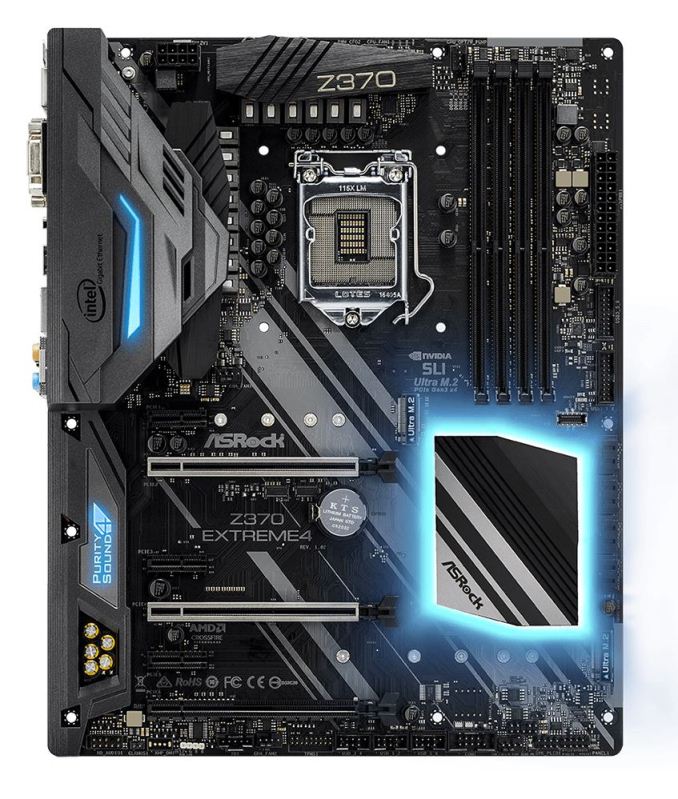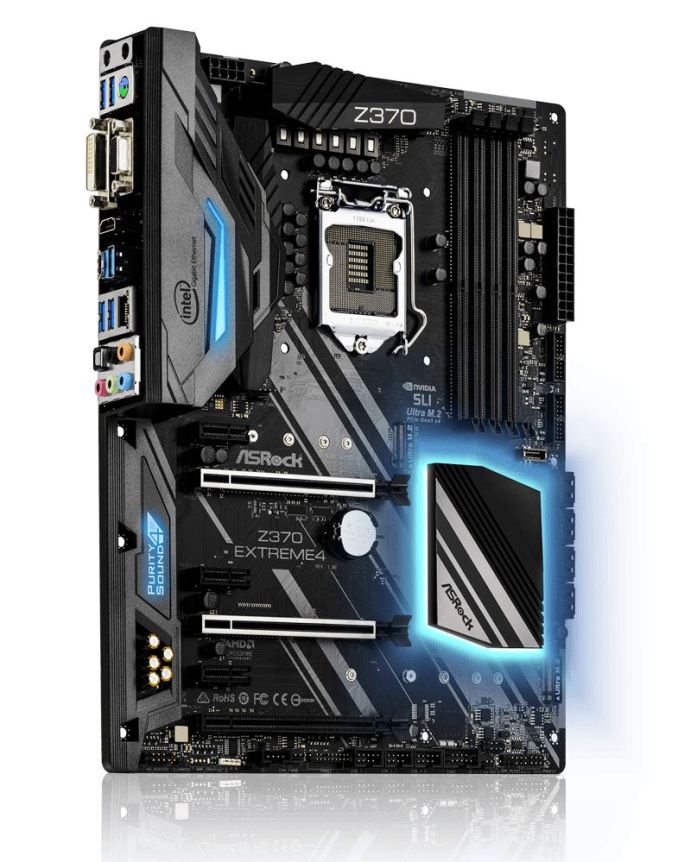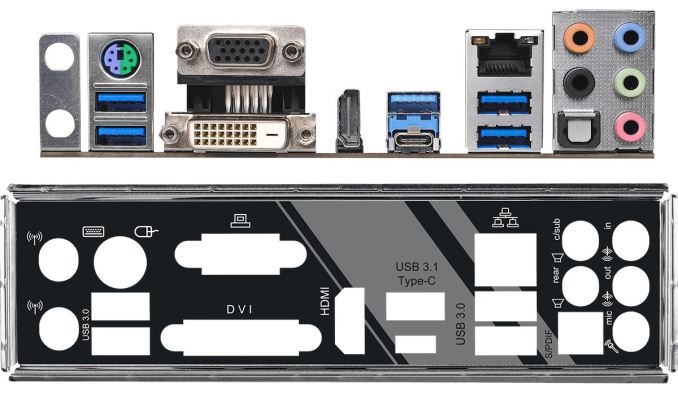Analyzing Z370 for Intel's 8th Generation Coffee Lake: A Quick Look at 50+ Motherboards
by Ian Cutress, Anton Shilov, Joe Shields & Gavin Bonshor on October 20, 2017 2:00 PM ESTASRock Z370 Extreme4
The ASRock Extreme4 is the flagship in the Extreme lineup, offering some of the same features as the Fatal1ty Gaming line. It uses the same flavor of power delivery with 60A chokes, Nichicon Combo caps, and Dual-Stack MOSFETs. What is missing on the overclocking front is the Hyper BCLK generator, so the range in which one can adjust the BCLK may not be as wide. This shouldn’t be a big issue for most considering the unlocked CPUs which will likely find their way into this socket.
The Z370 Extreme4 uses an all-black PCB with a few ‘racing’ stripes running through the board from the top left to the bottom right through the PCIe area and chipset heatsink. The Extreme4 uses the same shape and style VRM heatsinks found on the high-end boards, albeit without a heatpipe connecting them. The same style shrouding over the back panel and audio section is carried over from the flagship, and contains RGB LED features as well. The chipset heatsink is different, a bit more basic, and has RGB LEDs underneath. All the RGB LEDs, including the RGB header, can be controlled with ASRock RGB LED software.
Supported memory speeds on the Extreme4 reach up to DDR4-4333, with up to a 64 GB capacity. The top two slots are from the processor, and use reinforcement for holding heavy GPUs. The lane breakdown should be familiar with x16 cards single and x8/x8 in dual mode, while the final non-reinforced full-length PCIe slot has an additional PCIe x4 bandwidth from the chipset. There are also three x1 slots from the chipset.
Eight SATA ports are found on the board, with six using the chipset and another two using the ASM1061 (which uses a chipset PCIe x1 connection to create the two additional SATA ports). Two M.2 slots are found on the board with the top supporting up to an 80mm drive and the bottom supports 110mm drives. Lane sharing is required here when SATA drives are in play, with SATA ports 0/1 disabled when the first M.2 slot is used and the SATA 4/5 ports are disabled when the second M.2 slot is used.
Fan control is handled through the BIOS or via the F-Stream software, and it gives control to all the 4-pin headers: A CPU fan header (1A/12W), 2 chassis fan headers, and a chassis optional/water pump header (1.5A/18W). Audio duties are taken by the latest ALC1220 codec, which uses Nichicon Gold series audio caps, a Texas Instruments NE5532 headset amplifier, and the whole audio subsystem has PCB separation of the audio components from the rest of the board. Network functionality is handled by a single Intel I219-V network controller.
There are two USB 3.1 (10 Gbps) Type-A and Type-C ports on the rear panel via an ASM3142 controller, and four USB 3.1 (5 Gbps) ports fed from the chipset. Internally there are an additional three headers for USB 2.0 providing 6 ports, and two headers for USB 3.1 5Gbps support driven by the chipset or ASM1074 hub. There is also an additional new generation USB header, but this looks like it is only at 5 Gbps. The rest of the back panel consists of space for a Wi-Fi antenna in the E-key space, a combination PS/2 port, D-Sub, DVI-D, and HDMI ports for video output, and the 5 plug plus SPDIF audio stack.
| ASRock Z370 Extreme4 | |
| Warranty Period | 3 Years |
| Product Page | Link |
| Price | Amazon US |
| Size | ATX |
| CPU Interface | LGA1151 |
| Chipset | Intel Z370 Express |
| Memory Slots (DDR4) | Four DDR4 Supporting 64GB Dual Channel Support DDR4 4333+ |
| Network Connectivity | 1 x Intel I219-V GbE |
| Onboard Audio | Realtek ALC1220 |
| PCIe Slots for Graphics (from CPU) | 2 x PCIe 3.0 x16 slots @ x16 or x8/x8 |
| PCIe Slots for Other (from Chipset) | 1 x PCIe 3.0 x16 slots @ x4 3 x PCIe 3.0 x1 slots |
| Onboard SATA | 6 x Chipset 2 x ASM1061) |
| Onboard SATA Express | None |
| Onboard M.2 | 3 x PCIe 3.0 x4 - NVMe or SATA |
| Onboard U.2 | N/A |
| USB 3.1 (10 Gbps) | 1 x Type-C (ASMedia) 1 x Type-A (ASMedia) |
| USB 3.0 (5 Gbps) | 4 x Rear Panel 1 x Header 1 x ASM1074 Header |
| USB 2.0 | 3 x Headers |
| Power Connectors | 1 x 24-pin EATX 1 x 8-pin ATX 12V |
| Fan Headers | 1 x 4-pin CPU 1 x 4-pin Waterpump (1.5A/18W) 2 x 4-pin Chassis Fan 1 x Chassis Optional/Water Pump (1.5A/18W) |
| IO Panel | 2 x Wi-Fi Antenna ports 1 x PS/2 keyboard/mouse port 1 x HDMI port 1 x D-Sub port 1 x DVI-D port 1 x Optical SPDIF Out Port 1 x USB 3.1 (10 Gbps) Type-C 1 x USB 3.1 (10 Gbps) Type-A 4 x USB 3.1 (5 Gbps) Type-A ports 1 x LAN (RJ45) ports 1 x Optical S/PDIF out 5 x Audio Jacks |













83 Comments
View All Comments
weevilone - Wednesday, October 25, 2017 - link
Notable that though the new boards are often very similar to their Z270 predecessors, Asus has dropped Thunderbolt 3 support from the Maximus X Hero board.masouth - Thursday, October 26, 2017 - link
ASUS ROG Z370 Maximus X Hero"....new metallic heat sinks that are an upgrade over the plastic heatsinks found on the Z270 version"
Please excuse my ignorance because I didn't own a ROG Z270 mb but...plastic HEAT SINKS? Not shrouds or decoration over a heat sink but the actual heat sinks themselves? That's either wrong, they performed their job pretty poorly, or plastic resins have advanced a lot farther in thermal conductivity (and cost for such) than I realized.
flowrush - Sunday, November 19, 2017 - link
"The other main distinguishable feature is the inclusion of integrated 802.11ac Wi-Fi with an antenna (that can only be described as a shark fin) found on the F."The above is incorrect in the article. The integrated Wi-Fi module with antenna is found on the E not the F.
Coldgame - Saturday, November 25, 2017 - link
I'm looking to build a rig with the Z370 Gaming ITX/ac, a GTX-1070 card and an Apple Thunderbolt Display.The review states:
"The key difference in the support between the two boards is going to be the Thunderbolt 3 port on the Gaming-ITX. This port supports video outputs..."
So, can anyone confirm or deny that video generated by the GTX-1070 can be output through the onboard Thunderbolt 3 port?
hanselltc - Sunday, December 3, 2017 - link
Looking forward to low-middle end mITX choices from this platform. It'll probably be paired with a 8100/8300 and be my secondary machine.Roen - Sunday, February 4, 2018 - link
Where are the 10 Gbps ports on the back? They all look like 5 Gbps ports, even the Type C.rbarak - Wednesday, February 21, 2018 - link
Is anyone using the Z370-P on Linux with two screens?I built a new machine based on the Z370-P, and both the DVI and the HDMI connected screens show the same image, and the RHEL7 setup/displays show only one Unknown Display.
I follwed the advice on stackexchange, and added this line:
$ grep GRUB_CMDLINE_LINE_DEFAULT /etc/default/grub
GRUB_CMDLINE_LINE_DEFAULT="i915.alpha_support=1"
Then I did:
sudo grub2-mkconfig -o "$(readlink /etc/grub2.conf)"
And rebooted, but still, the two displays are not shown.
dromoxen - Wednesday, May 9, 2018 - link
Shocked to see that both the Asrock mitx boards are "szie=ATX" .. LOLThe addition of Tunderbolt sure seems to add a hefty premium £120 vs £160 , luckily I can do without.
Kroebo - Sunday, October 7, 2018 - link
Sadly, I discovered that the ZUG Gaming PLUS doesn't support SLI.trag - Tuesday, January 15, 2019 - link
On the ASrock Z370M Pro4 the M.2 slot information is backwards. Both slots support NVME. One slot also supports SATA. As written, "The first M.2 slot is SATA only while the second supports PCIe." it seems to say that one slot is SATA only and the other slot is PCIe (NVME) only.